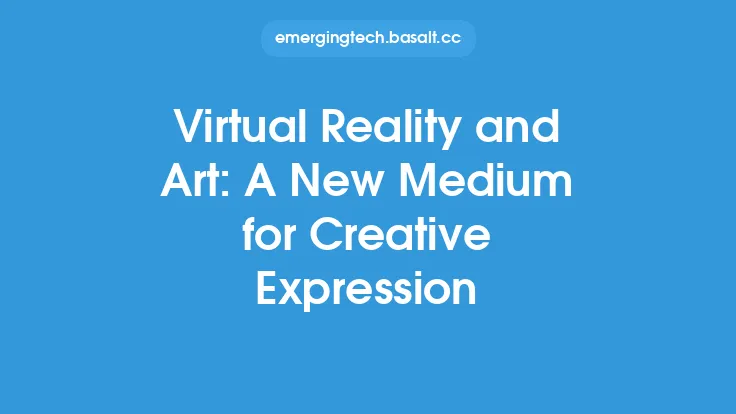The concept of virtual reality (VR) has been around for decades, but it's only in recent years that the technology has advanced to the point where it's become a viable and immersive medium for entertainment, education, and other applications. At the heart of any VR system is the display technology, which is responsible for rendering the virtual environment in a way that's indistinguishable from reality. In this article, we'll take a deep dive into the world of virtual reality display technology, exploring the different types of displays, their characteristics, and the technical challenges that come with creating an immersive VR experience.
Introduction to Virtual Reality Display Types
Virtual reality display technology can be broadly categorized into several types, each with its own strengths and weaknesses. The most common types of VR displays are head-mounted displays (HMDs), standalone displays, and projection-based displays. HMDs are the most popular type of VR display, and they're characterized by a headset that's worn on the head, with a display screen in front of the eyes. Standalone displays, on the other hand, are self-contained units that don't require a separate computer or console to operate. Projection-based displays use a projector to display the virtual environment onto a screen or surface.
Display Characteristics: Resolution, Field of View, and Refresh Rate
When it comes to VR display technology, there are several key characteristics that determine the quality of the experience. Resolution, field of view, and refresh rate are three of the most important factors to consider. Resolution refers to the number of pixels that make up the display, with higher resolutions resulting in a sharper and more detailed image. Field of view (FOV) refers to the extent of the virtual environment that's visible to the user, with a wider FOV resulting in a more immersive experience. Refresh rate, on the other hand, refers to the number of times the display updates per second, with higher refresh rates resulting in a smoother and more responsive experience.
Display Panels: LCD, OLED, and Micro-LED
The type of display panel used in a VR headset can have a significant impact on the overall quality of the experience. There are several types of display panels available, including liquid crystal display (LCD), organic light-emitting diode (OLED), and micro-LED. LCD panels are the most common type of display panel, and they're characterized by a layer of liquid crystals that block or allow light to pass through a matrix of pixels. OLED panels, on the other hand, use an emissive technology, where each pixel emits its own light, resulting in a higher contrast ratio and faster response time. Micro-LED panels are a newer type of display technology that uses a micrometer-scale LED array to produce the image, resulting in a higher contrast ratio, faster response time, and lower power consumption.
Lens and Optical Systems
The lens and optical system in a VR headset play a critical role in determining the quality of the experience. The lens is responsible for focusing the image from the display panel onto the user's eyes, while the optical system is responsible for correcting for distortions and aberrations. There are several types of lens and optical systems available, including fresnel lenses, aspheric lenses, and free-form optics. Fresnel lenses are a type of lens that uses a series of concentric rings to focus the image, resulting in a thinner and lighter lens. Aspheric lenses, on the other hand, use a non-spherical shape to correct for distortions and aberrations, resulting in a sharper and more detailed image.
Eye Tracking and Foveated Rendering
Eye tracking and foveated rendering are two technologies that are becoming increasingly important in VR display technology. Eye tracking refers to the ability of the headset to track the user's eye movements, allowing for a more precise and efficient rendering of the virtual environment. Foveated rendering, on the other hand, refers to the ability of the headset to render the virtual environment in a way that's optimized for the user's gaze, resulting in a more efficient use of processing power and a higher quality image.
Technical Challenges and Limitations
Despite the advances in VR display technology, there are still several technical challenges and limitations that need to be addressed. One of the biggest challenges is the need for higher resolutions and faster refresh rates, which require more powerful processing hardware and more efficient display panels. Another challenge is the need for a wider field of view, which requires more advanced lens and optical systems. Additionally, there are also challenges related to latency, motion blur, and eye strain, which can be addressed through the use of more advanced display technologies and rendering techniques.
Conclusion and Future Directions
In conclusion, virtual reality display technology is a complex and rapidly evolving field that requires a deep understanding of display characteristics, display panels, lens and optical systems, and eye tracking and foveated rendering. While there are still several technical challenges and limitations that need to be addressed, the future of VR display technology looks promising, with advances in display panels, lens and optical systems, and rendering techniques expected to result in higher quality and more immersive experiences. As VR technology continues to evolve, we can expect to see more widespread adoption in fields such as entertainment, education, and healthcare, and a greater emphasis on developing more advanced and sophisticated display technologies that can deliver a truly immersive and interactive experience.





